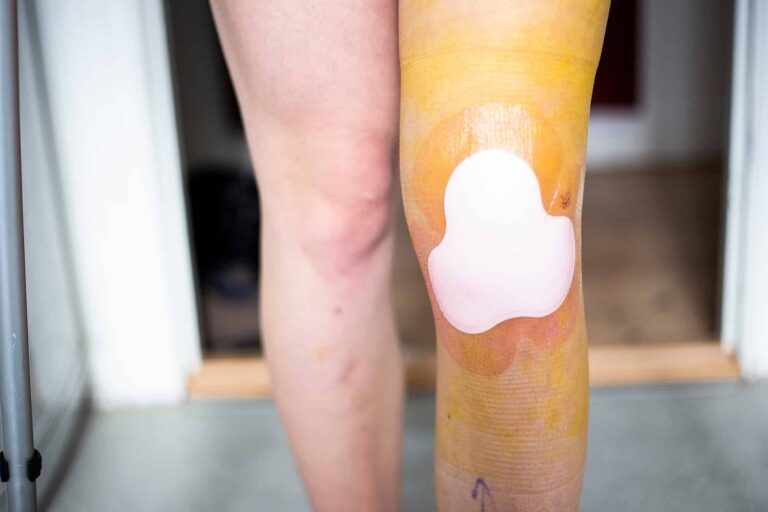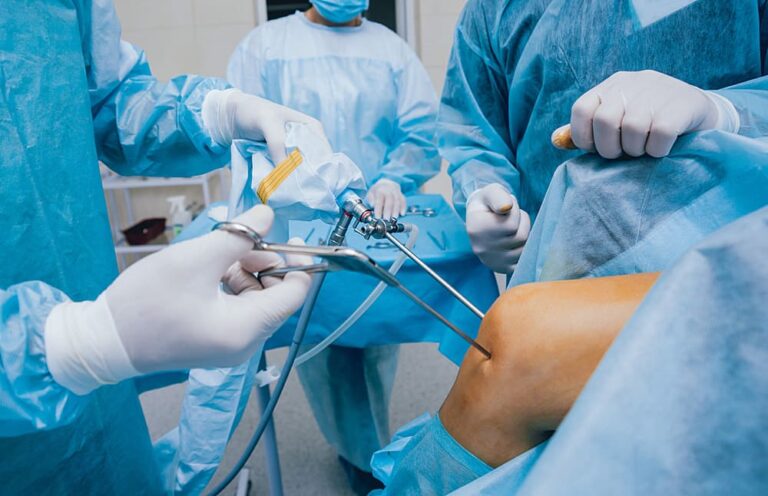Guide To Knee Arthroscopy in Singapore
April 20, 2022

If you’re experiencing knee pain, loss of motion, swelling or redness in the knee that isn’t improving with time or with non-invasive orthopaedic treatments, your doctor may recommend a knee arthroscopy surgery.
In fact, arthroscopic surgery is one of the most common operations performed when it comes to knee-related procedures. Besides treating damaged tissue, a knee arthroscopy can be used for diagnosis and recommending other treatments, like a knee replacement surgery.
What Is A Knee Arthroscopy?
A knee arthroscopy is a keyhole operation that orthopaedic surgeons use to treat structural problems inside the knee joint.
A fibre optic telescope known as an arthroscope is inserted into the knee joint through very small cuts at the front of the knee.
A camera is attached to the arthroscope, and a clear view of the inside of the knee joint can be seen on a video monitor. This allows your orthopaedic surgeon to examine all areas inside the knee joint.
It is a relatively safe procedure and the majority of patients are discharged from the hospital on the same day of surgery.

What Are The Reasons To Perform Arthroscopic Knee Surgery?
Not all causes of knee pain can be effectively treated with an arthroscopic procedure. Some of the key reasons to perform arthroscopic knee surgery include:
Torn Cartilage/Meniscus Surgery
Partial Meniscectomy is the official name of the surgery that involves the removal of a portion of the meniscus cartilage from the knee joint. The meniscus is a shock-absorbing wedge of cartilage that sits between the bone ends to provide cushioning and support. Smaller meniscus tears can usually be trimmed to relieve the symptoms of a torn meniscus.
Meniscus Repair
A meniscus repair is a surgical procedure done to repair the damaged meniscus. The meniscus repair can restore the normal anatomy of the knee and has a better long-term prognosis when successful. However, meniscus repair is a more significant surgery. The recovery is longer, and, because of limited blood supply to the meniscus, repair of the meniscus is not always possible.
ACL Reconstruction
The anterior cruciate ligament, or ACL, is one of four major knee ligaments. The ACL is critical to knee stability, and people who injure their ACL often complain of their knee giving out from under them. Therefore, many patients who sustain an ACL tear opt to have surgical treatment of this injury. A majority of the ACL surgery is performed arthroscopically.
Plica Excision
A plica is a remnant of tissue left over from foetal development. In early development, your knee was divided into separate compartments. The dividers of the compartments are gradually lost over time, but some remnants remain. When this remnant tissue is more prominent, it is called a plica. When the plica is irritated, it is called plica syndrome. A plica resection is performed to remove this irritated tissue.
Lateral Release
The kneecap moves up and down the end of the thigh-bone in a groove of cartilage. The kneecap can be pulled to the outside of this groove, or may even dislocate from the groove, causing pain with bending of the knee joint. A lateral release is performed to loosen the ligaments that pull the kneecap toward the outside of the groove.
Microfracture
Microfracture is a treatment used to stimulate the body to grow new cartilage in an area of damaged cartilage. In a microfracture procedure, the firm outer layer of bone is penetrated, to expose the inner layers of bone where marrow cells exist. These cells can then access the damaged area and fill in the gap of cartilage.
Autologous Chondrocyte Implantation
In this procedure, arthroscopic surgery is used to identify areas of cartilage damage and harvest cartilage cells. The person’s own cells are then grown in the lab and reimplanted in the joint in a separate procedure, which is an open surgery rather than arthroscopic surgery.
Cartilage Transfer/OATS
Cartilage transfer involves moving cartilage from healthy parts of the joint to damaged areas. Small plugs of cartilage are removed, with a portion of underlying bone, and transferred to the area of damage. The plugs are taken from areas of the joint where the cartilage surface is not needed.

What Are The Reasons To Perform Arthroscopic Knee Surgery?
Before The Procedure
Simple knee arthroscopy procedures are carried out in hospital as a day case. Occasionally you may need to stay overnight for medical reasons.
On the day of your arthroscopy, you will initially have a brief check up by your anaesthetist. The surgical team will prepare your knee with hair removal and a wash. In most cases, your knee arthroscopy will be carried out under a general anaesthetic.
During The Procedure
Your surgeon introduces an arthroscope into the knee through a small puncture wound beside the kneecap.
First, they’ll perform a thorough examination of the entire knee. Then they’ll investigate the specific problem as discussed with you during your consultation visits.
Your surgeon treats any cartilage damage, loose bodies and arthritis with small instruments through a second puncture wound on the other side of the kneecap. Photos are taken of your knee during your procedure.
At the end of the operation, the small puncture wounds will be closed with sterile strips and occasionally with sutures. The knee is then wrapped up with a sterile bandage.
After The Procedure
You will find 2-3 small puncture wounds under the compression bandage covering your knee.
These are made by the surgical instruments used during the procedure and are closed by tapes called steri strips.
Although these wounds are only small, the surgery inside your joint is quite significant and your joint will take time to recover. It is important that you follow the instructions to help heal and to maintain the muscle strength and range of movement of your knee.
Considering A Knee Arthroscopy? Let Us Help.
Dr. Ananda Vella is a Singapore and Swiss-double-fellowship-trained MOH-accredited orthopaedic specialist consultant surgeon, As a former consultant from the Singapore General Hospital and Sengkang General Hospital and with more than 20 years of experience, Dr Ananda treats a variety of orthopaedic bone and joint conditions, including in his subspecialty focus of foot and ankle conditions, hip and knee pains, as well as sports injuries. Dr Ananda is also well-versed in minimally invasive surgical techniques, including having performed the first lateral total ankle replacement surgery in South-east Asia to improve outcomes for patients with severe arthritis.
Dr Ananda regularly practices in 3 clinics across Singapore and is accredited to operate in all private hospitals in Singapore. Should you have any queries or need any further assistance, please do not hesitate to schedule an appointment with our Dr Ananda by WhatsApp at 8860 0642 for assistance. Alternatively, please leave us a message via the enquiry form and we will get back to you as soon as possible.
(All Rights Reserved)



